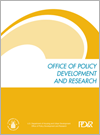
This HUD report completes the first comprehensive study of escrow management practices in the home mortgage servicing industry. The second volume of this study examines actual escrow management policies and practices by surveying selected accounts of more than 200 mortgage servicers, including the 20 largest companies in the industry. The survey found that single-item analysis accounting method used for almost 90 percent of all mortgage escrow accounts results in higher average and minimum balances than the alternative composite method, but the additional economic value of the float on the higher balances averages only $8 per year. Two other components of servicing-preaccrual and reserve-have a greater impact than the choice of accounting method on the average annual balances that determine float value. Using the single-item accounting method, approximately 10 percent of mortgages are overescrowed with respect to the legal maximum; however, almost two-thirds of all mortgages maintained balances that were less than half the maximum allowed. The survey found that State tax collection policy and servicer escrow policy were the two most important factors in determining average balance. If servicers were to adjust all of their accounts to the maximum levels allowed under Federal law, borrowers could be required to pay between $8.2 billion and $11.1 billion in additional escrow charges.
Publication Categories:
Publications
Affordable Housing
Public and Assisted Housing
Other Assisted Housing


